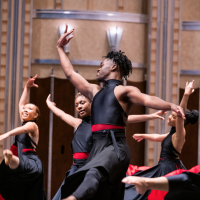Well, we’ve jumped with both feet into the 2008 presidential race, with Iowa and New Hampshire behind us and Super Tuesday, the conventions and the long march to November ahead.
While Americans for the Arts has documented those candidates who have made formal statements supporting the arts, I note that nowhere in the array of issues being publicly discussed by the candidates so far has the arts had any play – at any level of meaning – that I have been able to discover. So it is interesting to note that, softly, quietly, virtually without a ripple on the consciousness of the public, President Bush signed off on a $20 million increase to the budget of the National Endowment for the Arts, which now stands at $144 million for the coming year.
It is a sure thing that Ohio again will be a critical state in the upcoming elections. Cuyahoga County will again see a steady stream of candidates moving through our streets, suburbs and homes. As they do, I hope that Northeast Ohio citizens, who also approved a near-$20 million increase to arts support in 2006, will challenge candidates on their position on the arts.
Both Democrats and Republicans have championed education reform, and some have been strong on the need to revise or even vacate the No Child Left Behind legislation because it leaves too many children behind – especially the creative, unconventional thinkers and learners among our youth. Let’s ask them what role they think the arts have in reaching these children and in teaching to the whole of every child’s abilities – not just the capacity to memorize facts and take tests. And, for that matter, let’s ask them what role they believe the arts themselves play in a civilized and civilizing society.
Journalist/critic Andrew Adler of the St. Louis Courier recently wrote: “Arts policy may not be as white-hot-relevant as combating al-Qaida and other terrorists, but it remains intrinsic to the peculiar notion that Americans ought to be free to express themselves through culture, and that a government that helps fund such expression is an enlightened government.” Read his comments here.
I was fascinated by a recent C-SPAN broadcast of a speech by Vincent Virga, photography editor for the Library of Congress and author of a recent book, “Cartographia: Mapping Civilizations.” Mr. Virga’s book contains remarkable and incredibly beautiful maps made by artists and artisans of ancient civilizations to show how they perceived themselves in and of their worlds – both physical and spiritual.
Among these was a remarkable set of maps of the last presidential election created by the University of Michigan. These maps colored the country red and blue by county, rather than just by state, revealing a far more integrated voting pattern than what the simplistic state map we have all seen would suggest. We are not as separate and isolated as some would have us believe.
Then the enlightened folks at Michigan took it a step further: They weighted their map by population, which created a beautifully, fluidly expanded view of the country that showed far more accurately than simple land mass the distribution and impact of population centers across the U.S. Called a “cartograph,” this artful map put me in mind of a dance, or a symphony or poem, where layers and depths of communication exist in a far more subtle and complex pattern of meaning than does a sound bite, slogan or whole states colored red or blue by virtue of a small majority of votes. Check it out for yourself.

Pingback: Questions for the next president | Brewed Fresh Daily
Pingback: Remains of the Day, 1-27-08, Politics Edition | Writes Like She Talks